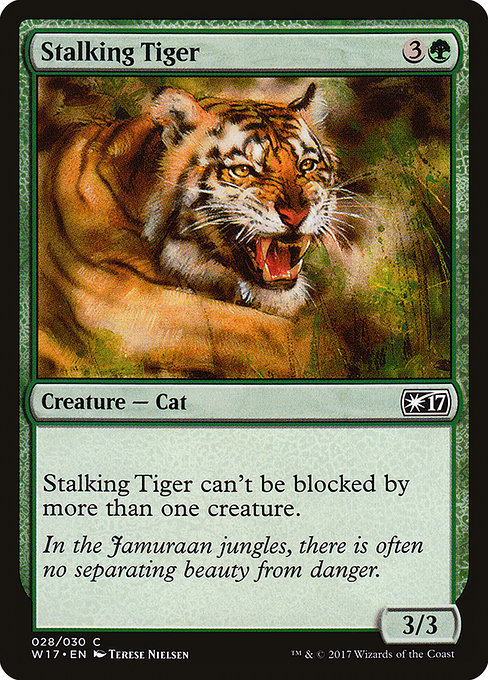
Image courtesy of Scryfall.com
Stalking Tiger: Combat Odds in a Green Tempo World
Green often rides the rhythm of big threats and resilient bodies, but Stalking Tiger reminds us that a single creature can tilt the balance of a combat step with precision. This 3/3 cat for 4 mana might look ordinary at first glance, yet its evergreen flavor and strategic implications run deeper than its stat line. The card from Welcome Deck 2017, illustrated by Terese Nielsen, is a small but mighty study in how probability and decision-making shape every attack you commit to the battlefield 🧙♂️🔥💎.
Understanding the blocking constraint
This creature’s defining line of text—“This creature can't be blocked by more than one creature”—isn’t just flavor. It constrains how combat can unfold when multiple blockers exist. In practical terms, there are two mutually exclusive outcomes for each attack: either Stalking Tiger is unblocked, or it is blocked by exactly one creature. There can’t be a double-block or multiple blockers on this attacker. That simplification is golden for calculating expected damage and planning follow-up plays 🧙♂️⚔️.
From a probabilistic perspective, the defender’s choice comes down to two levers: (1) the decision to block at all, and (2) which single blocker among those that can legally block is chosen if a block occurs. If you model the situation with the variable p representing the defender’s probability of blocking, and B the number of legal blockers, we get a compact intuition:
- Probability the Tiger is blocked: P(blocked) = p
- Conditional choice among blockers: if blocked, each blocker has a 1/B chance of being the one that stops the Tiger
That means in a world with two potential blockers and a 60% chance the defender blocks at all, there’s a 60% chance Tiger is blocked, and if blocked, there’s a 50/50 split as to which creature does the job. With three blockers and a 40% blocking rate, you’re looking at Tiger being blocked 40% of the time, with a 1/3 chance of being stopped by any particular blocker when a block occurs. These tiny numbers matter when you’re weighing how to finish a game, not just land a big hit in the next swing 🧙♂️🎲.
What happens in the math of combat
When Stalking Tiger is unblocked, it delivers 3 damage to the opponent. That is a clean 3 points of pressure you can count on, which is particularly meaningful in the midgame where every point matters. If Tiger is blocked by a single creature—remember, it can never be blocked by more than one—the outcome hinges on the blocker’s power and the blocker's toughness, alongside Tiger’s own 3/3 body. In many standard cases, a 3/3 against a 3/3 results in a mutual trade, wiping both attacker and blocker from the battlefield. If the blocker is smaller, Tiger might survive to threaten again; if larger, Tiger may trade unfavorably. In practice, the “blocked” line often ends in a trade, but the exact results depend on the battlefield context and any pump or anthem effects your deck has accumulated 🔥🎨.
Key takeaway for players focusing on probability: you can tilt the odds by sequencing your actions. If you want to maximize the chance Tiger lands damage, you might invest in a few green ways to increase p (the blocker decision) in your favor or reduce the amount of life your opponent keeps by pressuring them with unblocked swings. Green offers a toolkit—pump spells to push Tiger through a single, stubborn blocker, or buffs that outsize typical chump blockers. Embrace the math: more unblocked swings equal more damage; more blocked swings demand plan B and perhaps a follow-up creature or a pump spell to swing the outcome in your favor 🧙♂️💎.
“In the Jamuraan jungles, there is often no separating beauty from danger.”
Flavor and function align in Stalking Tiger: a lean predator designed to threaten when the board is open, yet a bruiser that demands respect when the path is blocked. The art by Terese Nielsen captures that primal tension—the sleek cat in a lush, unknowable jungle—and the card’s role in Welcome Deck 2017 highlights how a well-timed attack can teach newer players about combat probabilities and strategic risk-taking. The bilingual lesson here is simple: sometimes your best move is not to force a trade, but to force a choice. And in that choice, your opponent reveals their own probability model—block now, or let 3 damage slip through and set up a follow-up threat on the next turn 🎲🎨.
Practical guidelines for crafting around Stalking Tiger
- Anticipate blocks: if your deck relies on large swings, pair Tiger with a pump spell or a backup attacker that thrives when the opposing creature trades. This elevates the value of the unblocked outcome.
- Manage your tempo: in a format where you don’t always know what your opponent will draw, having a plan for both blocked and unblocked scenarios helps you maximize damage when the coast is clear 🧭.
- Learn the limits: a single green creature can sometimes force a difficult decision for your opponent, especially when they are sandwiched between pressure and removal. The probability of blocks—and the resulting board state—will shift with every draw you both make 🔥.
Whether you’re playing casually with friends or building a more deliberate green tempo deck, Stalking Tiger offers a compact, teachable microcosm of combat probability. It’s the kind of card that makes new players think in terms of odds and outcomes rather than just numbers on a sheet, and it lets veterans appreciate how a single text box can steer an entire game plan 🧙♂️⚔️.
If you’re mapping out a study session or a new-mint MTG night, a comfortable desk helper can make a difference as you crunch these odds. Consider pairing this kind of analysis with a handy companion accessory—for a practical nod to the habit of studying lists and probabilities, check out this Custom Rectangular Mouse Pad (9.3x7.8 in) to keep your notes within easy reach.